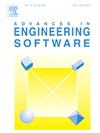Structural topology optimization considering material anisotropy induced by additive manufacturing processes
IF 5.7
2区 工程技术
Q2 COMPUTER SCIENCE, INTERDISCIPLINARY APPLICATIONS
引用次数: 0
Abstract
This work proposes a structural topology optimization method to consider material anisotropy induced by additive manufacturing processes. To quantify the relationship between manufacturing processes and mechanical properties of formed materials, the building direction angle is introduced into a transversely isotropic material model as a design variable. An anisotropic material model related to the building direction is thus established. A parallel optimization framework for structural topology and building direction is proposed by extending the classical compliance minimization formulation. And, to be applicable to gradient-based optimization algorithms, sensitivities related to density and angle variables are derived separately. Especially, to overcome the convergence difficulties caused by the periodic angle variables, an adaptive reduction strategy for the feasible region of angle variables is proposed. Typical numerical examples verify the rationality of the proposed method. The results show that the building direction related process-induced anisotropy significantly affects the optimized structural properties. The fluctuation of the trigonometric functions related to the angle variables would lead to obvious iteration oscillation in the optimization process, which makes the optimization difficult to converge. The proposed adaptive reduction strategy is proven effective in addressing this challenge. Besides, typical numerical properties of the co-optimization of structural topology and building direction are also revealed.
考虑增材制造工艺诱导材料各向异性的结构拓扑优化
本文提出了一种考虑增材制造工艺引起的材料各向异性的结构拓扑优化方法。为了量化制造工艺与成形材料力学性能之间的关系,在横向各向同性材料模型中引入了建筑方向角作为设计变量。建立了与建筑方向相关的各向异性材料模型。通过扩展经典柔度最小化公式,提出了结构拓扑和建筑方向并行优化框架。并且,为了适用于基于梯度的优化算法,分别推导了与密度和角度变量相关的灵敏度。特别地,为了克服周期角变量带来的收敛困难,提出了一种角变量可行域的自适应约简策略。典型数值算例验证了该方法的合理性。结果表明,与建筑方向相关的过程引起的各向异性对优化后的结构性能有显著影响。在优化过程中,与角度变量相关的三角函数的波动会导致明显的迭代振荡,使得优化难以收敛。所提出的自适应减少策略被证明是有效的解决这一挑战。此外,还揭示了结构拓扑与建筑方向协同优化的典型数值特性。
本文章由计算机程序翻译,如有差异,请以英文原文为准。
求助全文
约1分钟内获得全文
求助全文
来源期刊

Advances in Engineering Software
工程技术-计算机:跨学科应用
CiteScore
7.70
自引率
4.20%
发文量
169
审稿时长
37 days
期刊介绍:
The objective of this journal is to communicate recent and projected advances in computer-based engineering techniques. The fields covered include mechanical, aerospace, civil and environmental engineering, with an emphasis on research and development leading to practical problem-solving.
The scope of the journal includes:
• Innovative computational strategies and numerical algorithms for large-scale engineering problems
• Analysis and simulation techniques and systems
• Model and mesh generation
• Control of the accuracy, stability and efficiency of computational process
• Exploitation of new computing environments (eg distributed hetergeneous and collaborative computing)
• Advanced visualization techniques, virtual environments and prototyping
• Applications of AI, knowledge-based systems, computational intelligence, including fuzzy logic, neural networks and evolutionary computations
• Application of object-oriented technology to engineering problems
• Intelligent human computer interfaces
• Design automation, multidisciplinary design and optimization
• CAD, CAE and integrated process and product development systems
• Quality and reliability.
 求助内容:
求助内容: 应助结果提醒方式:
应助结果提醒方式:


